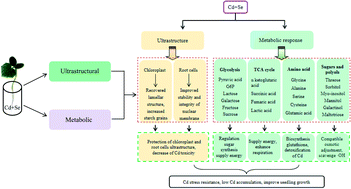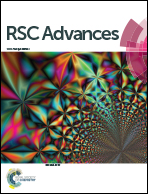Selenium modulates cadmium-induced ultrastructural and metabolic changes in cucumber seedlings†
Abstract
Intensive insight into the potential mechanisms of Se-induced Cd tolerance in cucumber seedlings is essential for further improvement of vegetable crop cultivation and breeding to obtain high yields and quality in Cd-contaminated soil. To reveal the ultrastructural and metabolic differences in Se-induced Cd tolerance, we examined the ultrastructures of chloroplasts and root cells and characterised 155 differentially expressed metabolites under Cd and/or Se stress using gas chromatography-mass spectrometry (GC-MS)-based metabolomics. Exogenous Se greatly relieved Cd-caused injuries to the ultrastructures of cucumber leaves and roots; for example, the shapes of chloroplasts treated with Cd + Se improved or even began to return to normal, the nuclei of root cells began to regenerate better and the chromatin was well-distributed compared with plants treated with Cd alone. Metabolite profiling revealed several intermediates of glycolysis and the tricarboxylic acid (TCA) cycle; also, some amino acids were up-accumulated in Cd + Se-treated cucumber seedlings and down-accumulated in Cd-treated cucumber seedlings, such as pyruvic acid, galactose, lactose, glutaric acid and alanine in leaves, glucose-6-phosphate and serine in roots, and lactic acid and glycine in both leaves and roots. These metabolites may play dominant roles in developing Se-mediated Cd tolerance. Moreover, a high level of sugars and polyols, amino acids and organic acids were up-accumulated in Cd-treated plants. Meanwhile, our data suggest that high accumulation of fructose, α-ketoglutaric acid, shikimic acid, fumaric acid and succinic acid in roots is a Cd-specific response, indicating that these metabolites are vital for cucumbers to develop Cd resistance. This study extends the current understanding of the mechanisms of Se in abating Cd contamination in cucumber and demonstrates that metabolomics profiling provides a more comprehensive view of the response of plants to heavy metals.

- This article is part of the themed collection: 2020 RSC Advances HOT Article Collection


 Please wait while we load your content...
Please wait while we load your content...